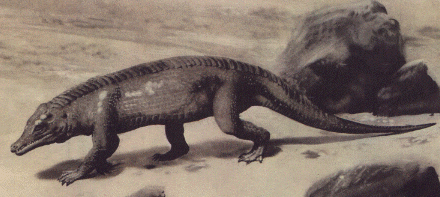
Vertebrate Fossils
As of 2001, only 8 vertebrate fossils sites have been found in the Navajo Ss. Recovered specimens include Protosuchus (crocodilian), Ammosaurus (prosauropod), Segisaurus halli (theropod), and tritylodont (therapsid).
Protosuchus (first crocodile) which was probably a land carnivore.
Protosuchus was not a dinosaur; it was a reptile that eventually led to the
crocodiles. This carnivore (meat-eater) had a long tail, a large, wide skull, and a narrow
snout with many large, dagger-like teeth. On the lower jaw, two large
teeth extended past the other teeth and fit into notches in the upper jaw.
Their body was covered and reinforced by scales, the long of their back, by a double row
of bony plates
It was a unusual quadrupedal reptile whose legs were columnar (and not sprawling out to the sides); the rear legs were longer than the front legs. It had five-toes and clawed feet and were probably both good runners and good swimmers.

Ammosaurus means "Sand Lizard" and was discovered by the paleontologist Othniel C. Marsh in the Navajo back in 1891. Ammosaurus was a medium-sized bipedal prosauropod. It had small feet and large hands with big claws on the thumbs.

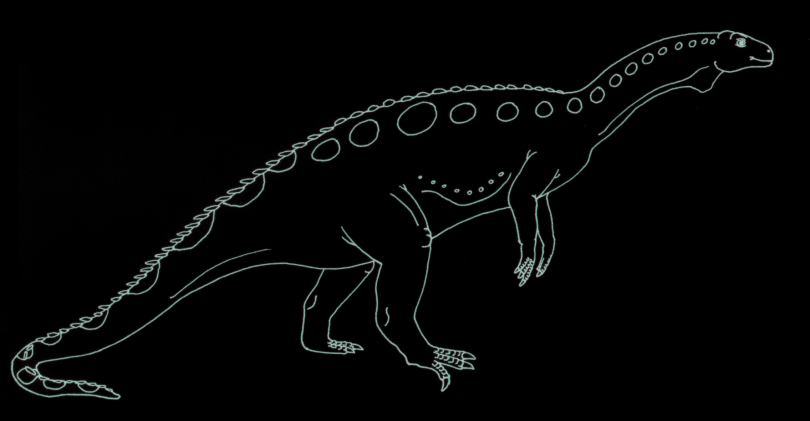
The prosauropod lineage of dinosaurs eventually produced the most massive land creatures of all time including the giants like Apatosaurus (=Brontosaurus), Brachiosaurus, and Argentinosaurus which may have weighed more than 100 tons. The Ammosaurus, however, probably weighed only about 85 lbs. It was a primitive plant-eater about 8 feet in length that was characterized by a small head, long neck, bulky body, small feet, big hands with thumb claws and a long tail. It could walk on all fours and stand up on its back legs.
Segisaurus halli is a small, mysterious theropod known from only
one specimen. It was a small ceratosaur (about the size of goose). It was 3
foot long and weighed 4-7 kg. It was a small and agile runner that
probably ate small lizards, amphibians and insects.

It was found in 1936 at Segi Canyon It was described by the famous UCMP field paleontologist Charles L. Camp.Two mysteries about Segisaurus perplex paleontologists. First, the specimen is nicely preserved (but fragmentary), except for one fact -- no skull! It is the only specimen of its kind, and its relationship to other ceratosaurs is complicated by the fact that we are uncertain of what its head looked like. It may in fact be a ceratosaur that we already know of rather than a unique genus (but this seems unlikely due to a few unique features that it possesses). Another, more confusing fact about Segisaurus is that the bones appear to be solid according to some paleontologists. As you may know, theropod bones are hollow, so it would be amazing to find a theropod without hollow bones. However, the seemingly solid bones may an artifact of the chalk-like preservation. Paleontologists at Berkeley are currently working to solve the mystery of Segisaurus and John R. Hutchinson of UCMP recently reported that the bones were in fact hollow.
Tritylodontidae were small to medium-sized extremely mammal-like cynodont synapsids that superficially resembled extant rodents. They were quadrupedal, long bodied and the structure of the shoulder girdle and forelimb suggests capability for scratching and digging. Their numerous fossilized burrows found in the Navajo Sandstone attest to this fact. The had large forefeet and wide unguals that may have suited the animal well for progression across loose sand. How a large population of these herbivores could exist on the sparse vegetation of the Navajo Ss erg is somewhat of a mystery. Tritylodontidae were part of a larger group of animals called Therapsida that eventually led to the evolution of mammals.

About the time that Archosaurs (ruling reptile) ancestors were just starting to diversify came the crocodiles. One of the first was
Tritylodont specimen (headless) reported by Winkler, et. al. (SMU)
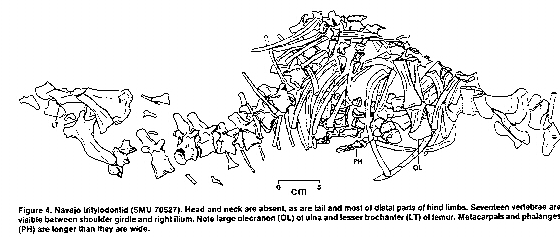
To see the burrows that these animals may have made go to the vertebrate trace fossil section
Bonus Question: Were Pterosaurs part of the Navajo Ecosystem?
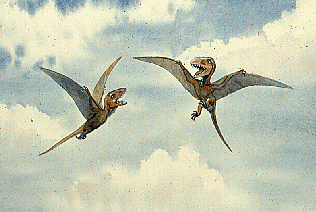
Pterosaurs in flight
Courtesy of UC-Berkley
Pterosaurs were flying reptiles that filled an ecological niche similar to sea gulls and storks today. They had hallow bones to help them fly and in the early Jurassic had long tails. There are tracks in the Navajo Ss that Martin Lockley believes were made by pterosaur (see image below). Note the extended 4th finger which may have been part of pterosaur wing assembly. The second image is a pterosaur fossil from a different formation (courtesy UC Berkley).
No fossilized bones have been found in the Navajo and this is not unexpected given the fact that the pterosaur bones were hollow and the Navajo environment was not the best to preserve fragile detail.
has the curious characture of of pterosaur including a tail section but no bone material is evident at the site. The length of the fossil (30") is consistent with the known size of pterosaurs 190 million years ago. Some banding is also noted in the tail section.
Compare this image with an actual pterosaur fossil from a different
geologic formation.
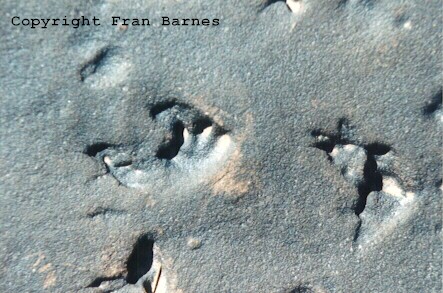
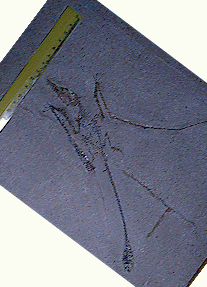
Possible
pterosaur tracks in Navajo
Actual pterosaur fossil (UC Berkley)


Curious Navajo trace fossil
Close up of tail section - Note banding)
(Photo by
Paul Ostapuk - Navajo Canyon)
Vertebrate Skeletal Fossils Invertebrate Skeletal Fossils
Vertebrate Trace Fossils Invertebrate Trace Fossils
Petrified Wood and Flora Casts Fresh Water Deposits